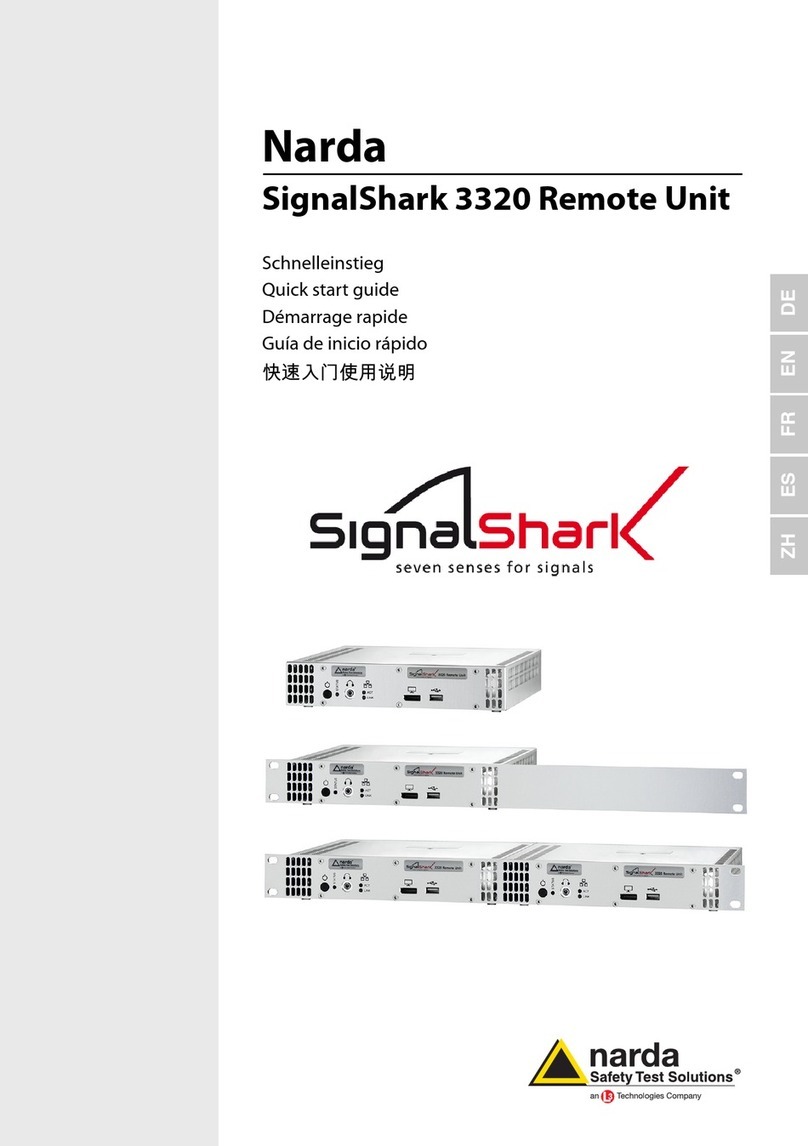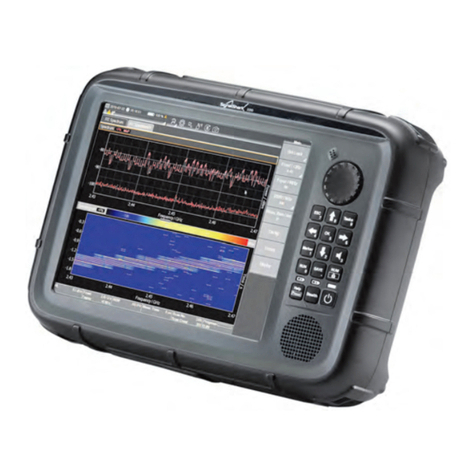
VI Contents
10 PMM 9030 EMI Signal Analyzer 30 MHz – 3GHz (Option)
10.1 Introduction to PMM 9030…………………………………………………
10.2 Instruments items………..…………………………………………………
10.3 Optional PMM accessories………..………………………………………
10.4 Other accessories…………………..………………………………………
10.5 Main specifications.………….………..……………………………………
10.6 Front and rear panel……………………………………………………….
10.7 Functional description……………………………………………………..
10.8 No coaxial cable between the antenna and the receiver………………
10.9 Emission measurements………………………………………………….
10.10 Installation…………………………………………………………………
10.10.1 Introduction………………………………………………………………
10.10.2 Initial inspection…………………………………………………………
10.10.2.1 Packing and Unpacking……………………………………………...
10.10.3 Preparation for use……………………………………………………..
10.10.4 Battery charger………………………………………………………….
10.10.4.1 To replace the mains connector of the battery charger…………..
10.10.4.2 To charger internal battery……………………………………………
10.10.4.3 Indication of the battery status on the screen and with PW led….
10.10.5 Environment………………………………………………………………
10.10.6 Return for Service……………………………………………………….
10.10.7 Equipment cleaning…………………………………………………….
10.10.8 Equipment ventilation…………………………………………………..
10.10.9 Hardware installation……………………………………………………
10.10.10 PMM 9010+ PMM 9030 initial screen……………………………….
10.10.11 Led on the PMM 9010 and on the PMM 9030………………………
10.10.12 PMM 9010 + PMM 9030 main screen……………………………….
10.10.13 PMM 9010 + PMM 9030 Setup panel……………………………….
10.10.14 PMM 9010 + PMM 9030 Link failure…………………………………
10.10.15 Using an antenna………………………………………………………
10.11 Analyzer Mode Operating instructions…………………………………..
10.11.1 Introduction………………………………………………………………
10.11.2 Frequency………………………………………………………………..
10.11.3 RBW………………………………………………………………………
10.11.4 Level………………………………………………………………………
10.11.4.1 Input: Attenuators and preamplifier…………………………………
10.11.4.2 Misc…………………………………………………………………….
10.11.4.3 Detector………………………………………………………………...
10.11.4.4 Conversion factor……………………………………………………..
10.11.5 Marker…………………………………………………………………….
10.11.6 ESC……………………………………………………………………….
10.12 Sweep Mode Operating Instructions…………………………………….
10.12.1 Introduction………………………………………………………………
10.12.2 Measure…………………………………………………………………..
10.12.2.1 Frequency………………………………………………………………
10.12.2.2 Advanced……………………………………………………………….
10.12.2.3 Level…………………………………………………………………….
10.12.2.3.1 Input: Attenuators and preamplifier……………………………….
10.12.2.3.2 Misc…………………………………………………………………..
10.12.2.3.3 Tracking generator………………………………………………….
10.12.2.3.4 Detector………………………………………………………………
10.12.2.4 Conversion factor……………………………………………………...
10.12.3 Limit……………………………………………………………………….
10.12.4 Display…………………………………………………………………….
10.12.5 Marker…………………………………………………………………….
10.12.6 Load store……………………………………………………………..…
10.13 Manual Mode Operating Instructions……………………………………
10.13.1 Introduction………………………………………………………………
10.13.2 Frequency………………………………………………………………...
10.13.3 Level………………………………………………………………………
10.13.3.1 Input: Attenuator and preamplifier…………………………………..
10.13.3.2 Misc……………………………………………………………………..
10.13.4 RBW………………………………………………………………………
10.13.5 Hold Time………………………………………………………………...
10.13.6 Demodulator……………………………………………………………...
10-1
10-2
10-2
10-2
10-3
10-5
10-6
10-6
10-7
10-8
10-8
10-8
10-8
10-8
10-8
10-8
10-8
10-9
10-10
10-10
10-10
10-10
10-11
10-12
10-12
10-12
10-13
10-14
10-15
10-18
10-18
10-19
10-19
10-20
10-20
10-21
10-21
10-22
10-22
10-22
10-23
10-23
10-24
10-24
10-25
10-25
10-26
10-26
10-26
10-27
10-27
10-27
10-28
10-28
10-29
10-30
10-30
10-31
10-31
10-32
10-32
10-33
10-33
10-34





























